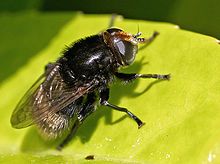- Merodon equestris
-
Merodon equestris 
Merodon equestris the Narcissus bulb fly Scientific classification Kingdom: Animalia Phylum: Arthropoda Class: Insecta Order: Diptera Family: Syrphidae Genus: Merodon Species: M. equestris Binomial name Merodon equestris
(Fabricius, 1794)Synonyms Merodon equestris (Narcissus bulb fly, greater bulb fly, large bulb fly, large Narcissus fly)[1] is a European species of hoverfly (Family Syrphidae).[2] Like other hoverflies it displays a coloration pattern similar to a stinging insect (a bumblebee in this case) as an evolutionary defense mechanism.
Contents
Distribution
M. equestris is a species native to Europe and namely the British Isles. It has been documented in North America, where it may have been introduced.
Feeding
The adult M. equestris feeds on the pollen and nectar of flowers from the genera Lilium and Narcissus.
The larvae of these flies are known pests found on the bulbs of these flowers, leading to the names bulb fly and Narcissus fly. This is unlike most other members of the family, which predate on aphids[3].
Physical characteristics
M. equestris is on average 12 millimetres (0.47 in) in length and is orange, black and yellow in colour.[3]
The legs of this species are always black. Paterns of venation on the wings can be used to identify the species.[4]
Mimicry of bees
This hoverfly has taken on characteristics of the bumblebee, including coloration and a hairy carapace. This can be misleading to birds and other animals who may try to eat it or interfere with its feeding.
Sexual dimorphism
Males and females display a body dimorphism common among hoverflies. This is evident in the eyes mostly; the eyes of the male M. equestris are larger and almost touch along the top of the head. Females have smaller eyes which are placed farther apart.
The genitalia of the two sexes differ as well; females have a pointed abdomen with inconspicuous genitalia while males have curbed asymmetrical genitals.[5].
References
- ^ "Hoverflies". http://www.bugsandweeds.co.uk/hoverflies.html. Retrieved 2009-12-12.
- ^ Stubbs, Alan E. and Falk, Steven J. (1983). British Hoverflies: An Illustrated Identification Guide. British Entomological & Natural History Society. pp. 253, xvpp.
- ^ a b "Narcissus Bulb Fly". http://whatcom.wsu.edu/ag/homehort/pest/bulbflies.htm. Retrieved March 3, 2010.
- ^ "Hoverflies (Syphidae), tribe Merodontini". http://www.gwydir.demon.co.uk/insects/merodontini.html. Retrieved March 3, 2010.[dead link]
- ^ "All about Hover Flies". http://www.microscopy-uk.org.uk/mag/artmay07/cd-hoverflies.html. Retrieved March 3, 2010.
Categories:- Hoverflies
- Diptera of Europe
- Animals described in 1794
Wikimedia Foundation. 2010.
